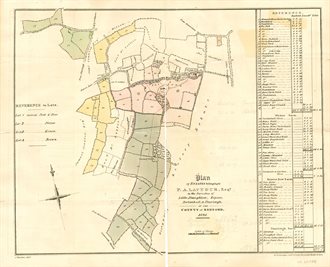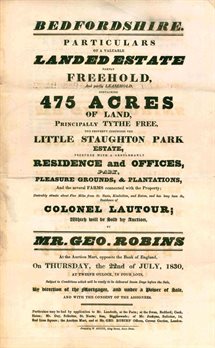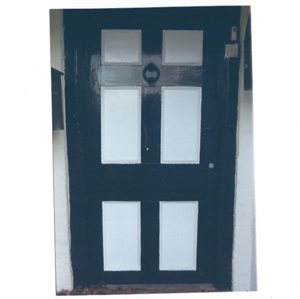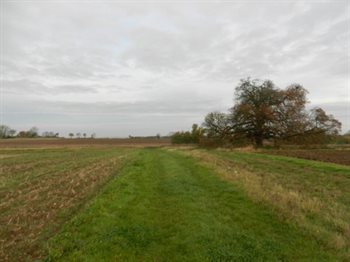Little Staughton Park Estate
Written by Brenda Foster and Jeanette Atkinson

Plan of Peter Augustus Lautour's estates 1828 [WG2481]
Little Staughton Park (later known as Staughton Lodge) was an estate built up by Peter Augustus Lautour from around 1814 until he went bankrupt in about 1830. Major Lautour, later General Lautour, was a decorated war hero who fought at Waterloo. Born in India in 1789 into the family of French aristocrat Joseph Francis Louis Lautour and his British wife, Anne Hordle [Burkes Landed Gentry 1847, page 694], Peter Augustus Lautour was one of at least six children. Many of his siblings married well and had substantial estates and good social connections within the British landed gentry of the 1800s.
Peter Augustus Lautour’s father died in 1807 after making a fortune in India working as a banker, merchant spice trader and property developer. Legal papers indicate that Peter Augustus Lautour was entitled to income from his father’s freehold estates [X163/124]. In 1822 he was appointed Sheriff for Bedfordshire [Bell’s Weekly Messenger, 10 February 1822].
The estate was substantial and consisted of sprawling lands in the parishes of Little Staughton, Keysoe, Pertenhall and Thurleigh. Some 475 acres, the estate comprised: an opulent seven bedroom mansion, a large conservatory, orangery, ice house, hot houses, lodge house, high fenced stallion paddock, stables and coach houses. There is evidence that racehorses may have been bred on the estate as Lautour is mentioned in newspapers at racecourses with various horses (Langtonian at Winchester in 1824 and May Day at Northampton in 1825). Lautour planted many trees, created a pleasure garden, lawns and walled garden. The main house (known locally as The Garden House) and farm buildings were based at West End, Little Staughton and were accessed from Keysoe Row East. The estate also included Wickey Farm, which was leased from Corpus Christi College, Oxford.
Peter Augustus Lautour appears to have been a speculative land investor in partnership with his brother-in-law Edward Marjoribanks of the Coutts banking family and others. As well as his North Bedfordshire holdings he bought land in Van Diemens Land (Tasmania) and Western Australia in the early 1800s. The New Zealand development may have ended up highly profitable, however Lautour was removed from his shareholding as a bankrupt. The Western Australia acquisition alone was over 100,000 acres. In both land developments, Lautour was an absentee landlord with managers but either he or they were negligent leading to spectacular failure in development and financial losses for all concerned [Journal Royal Australian Historical Society, 1986, volume 72, part 3, pages 226-240].
By 1830 Latour had been declared bankrupt by some of his creditors and as a result some of the Little Staughton Estate farmland was sold (circa 275 acres in 1830) and Little Staughton Park was conveyed to Henry Hobhouse of Her Majesty’s Privy Council. The original contents of the house were auctioned in August 1831 according to newspaper advertisements of the time [London Morning Advertiser, 6 August 1831]. The rest of the estate was leased to J H Burchall Esq. However, the 1841 census shows that the only occupants of the newly named ‘Staughton Lodge’ were two servants.

Catalogue for the sale of the Little Staughton Park Estate 1830 [WG2481]
Legal cases and court battles around the estate continued into the 1840s. In 1853 the estate was auctioned again [GA2104] and in 1855 a Mr Alfred Wright issued a prospectus in the hope of attracting potential students to a school he was establishing at the house [X67/682]. Within a year of his Little Staughton school opening, however, his creditors were calling in debts, Mr Wright was bankrupt and the school was closed.

Prospectus for Mr. Wright's school at Staughton Lodge 1855 [X67/682]
The last known occupier was the Hon. H B Cochrane who, in the Bedfordshire Directory for 1862, was listed as owning a glorious mansion plus 100 acres of woodland, plantations and pleasure gardens.
General Peter Augustus Lautour (who had lived in France from 1828 and returned to the army after 1834) died on the 11 January 1866 at Staughton Villas, Bromley [Kent]. His colourful life is well documented in legal records and newspaper cuttings of the time. He appears to have been in a relationship with Augusta Manners for over 10 years from 1810 but no record of their marriage can be found. She had at least six children by him; one, Peter Augustus Lautour junior was born in Little Staughton in 1816. Augusta Manners died in her late 30s in Snaresgate Street, Dover which was full of lodgings for monied travellers to the continent. She is buried in St Andrews Church, Buckland, Dover.
Lautour spent time in debtors’ prison in England, between May 1830 and July 1831 and again in 1851, and in France between 1832 and 1834. There was a contested divorce from the wife he married in 1826 (Una Cameron Barclay Innes who ran off with George Miles Davis, another prisoner in France in 1833), which was probably costly in terms of legal fees. He remained litigious to the very end of his life as his will contains a reference to monies owed to him by the Crown in respect of lands sold in Western Australia and outstanding issues around this investment. A report in Hansard ['The case of Colonel Lautour', HC Deb 29 July 1845, volume 82] indicates that Colonel Lautour believed he had more time to develop the Australian land before it was appropriated by The Crown. It is unknown how he attained or maintained his final rank of General in the army as he seemed to spend time in prison on numerous occasions. General Peter Augustus Lautour died leaving effects less than £100 in his will to his current partner and executor Agnes Marian Skato and her son.
Finally, Peter Augustus Lautour’s magnificent Little Staughton mansion that stood for only 50 years was demolished; it is not known when, but possibly around 1870. Unfortunately no painting or architects drawings of the mansion have been found. A large horse chestnut tree marks the site of the roadway to the mansion from West End/Keysoe Row; this is now a public bridleway that was once stopped up by Lautour [Bedford & Cambridge Gazette, 5 December 1818]. The bricks from the demolished mansion were used to build parts of the properties on Keysoe Row East (such as London End, Isis and Hazelmere). The main door to the mansion still exists and is found at Oxford Farm, Keysoe Row East. Some of the estate farm buildings stood on West End until the mid 20th Century.

Main door from Little Staughton Park, 2018

Bridleway, once the entrance to Little Staughton Park 2017